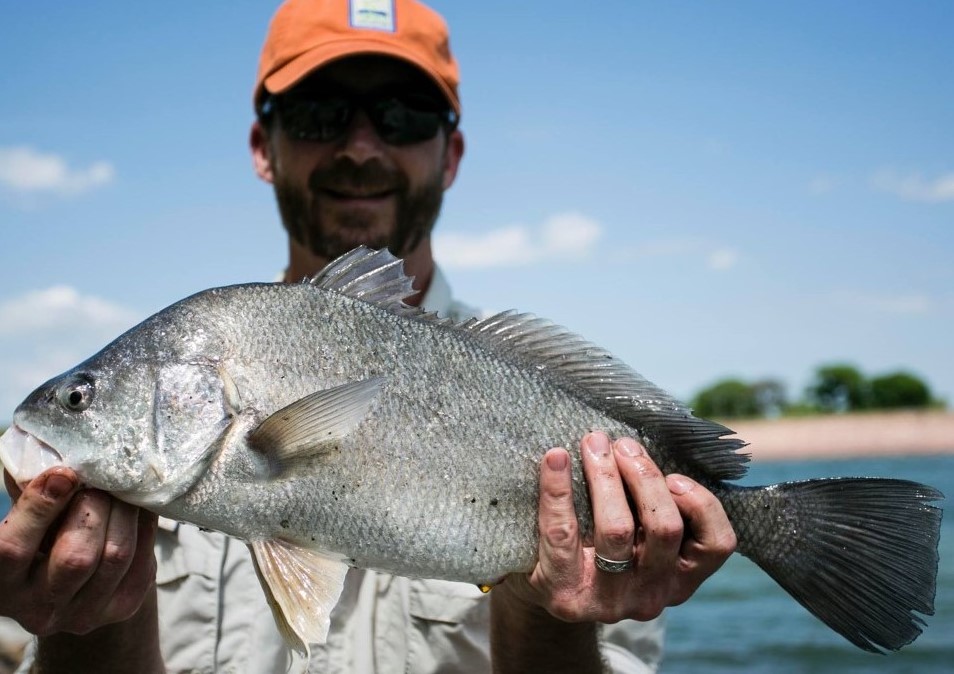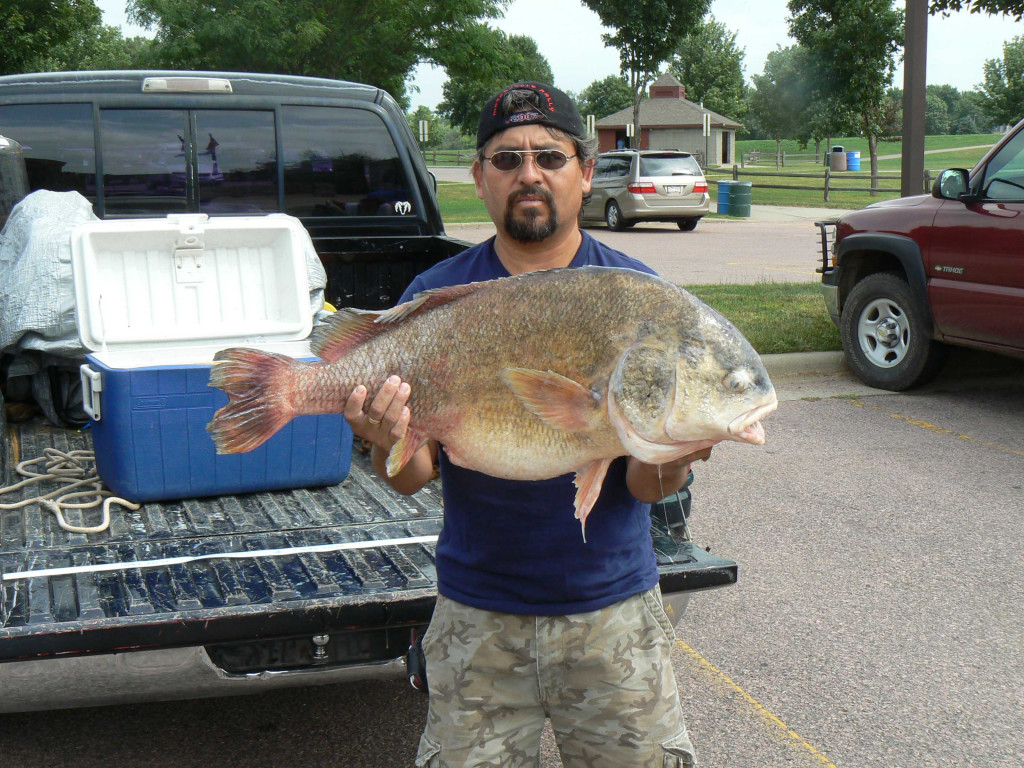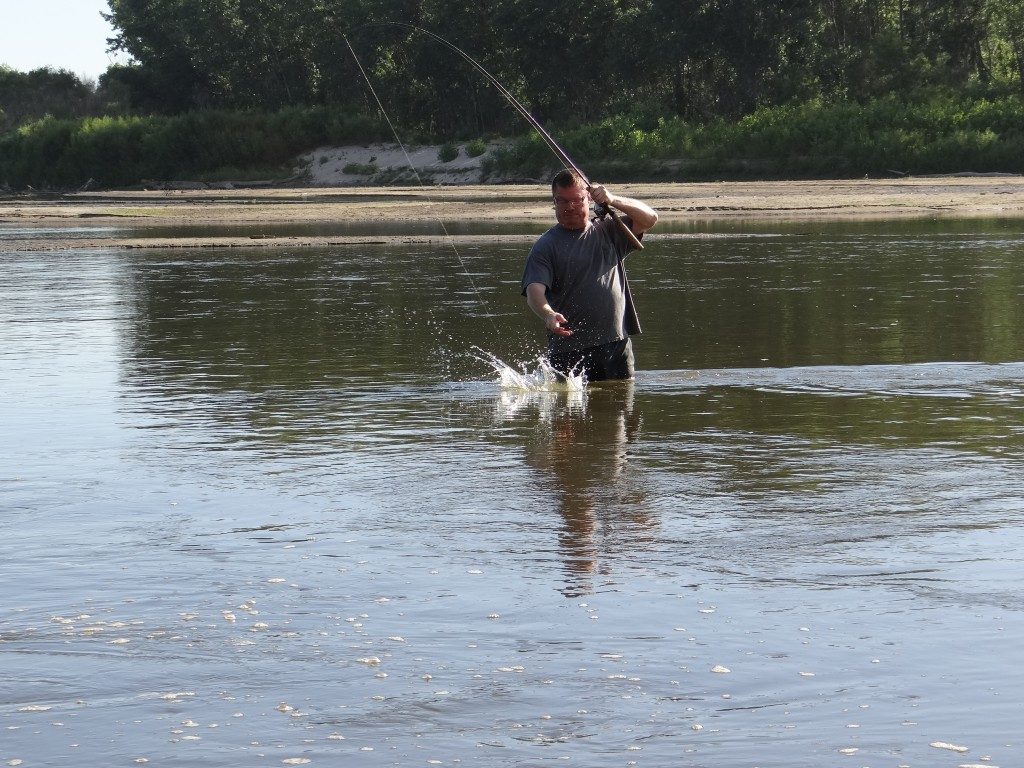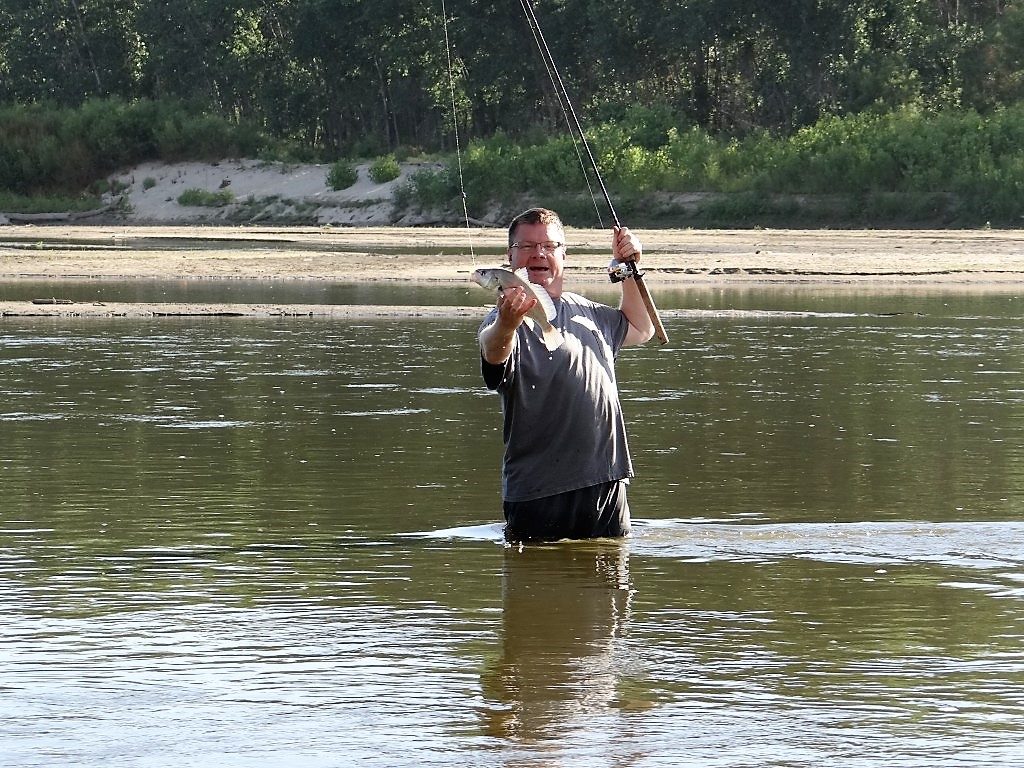I watched closely as the guy excitedly reeled in the fish he had hooked from a local sandpit lake in eastern Nebraska. Upon landing it, I heard him dismally say: “Oh man, it’s a damn drum, that’s a trash fish, I gotta throw this back.” At this point, I walked over to the man and casually said: “Hey, that’s a nice freshwater drum you’ve caught. Did you know those are good eating if you prepare them right?”
“Are you kidding me?” the fella stated. “I am not,” I replied.

It always baffles me why some anglers think certain fish are ‘no good’ or ‘trash fish.’
Freshwater drum unfortunately fall into those kinds of categories.
To fully understand and dispel myths about the fish, let’s examine it.

IDENTIFICATION
The freshwater drum, Aplodinotus grunniens, is a silvery to dusky-gray fish that can also have bronze/purple reflection. It is a deep-bodied with a white belly, blunt snout and down-turned mouth. Its prime trademarks are a highly arched back, long dorsal fin and the extension of the lateral line onto the rounded tail. The dorsal fin has a deep notch between the spiny and soft portions. The lips are milky white, and the pelvic fins are white, often tinged with orange. The drum grows to a hefty size, and some weighing more than 20 pounds are occasionally landed in Nebraska.

UNIQUE FEATURES
An interesting and somewhat unusual fish , the freshwater drum can produce a loud croaking or grunting sound by using muscles to vibrate its air bladder. The resulting “drumming” noise aptly accounts for its name. Some fisheries experts believe this rumbling vibration is emitted by mature males during the mating process. Many people probably hear this sound and never even realize it comes from a fish! Within its inner ear, the drum has what are called otoliths or “ear stones.”
An oddity among Nebraska’s fishes because of their large size, they are removed by some anglers and carried about as curiosities. Hard-shelled animals like crayfish (crawdads) are consumed and crushed by flattened teeth located on gill arches in their throats. Females release large quantities of floating eggs during spawning in late spring when water temperatures are 68-70 degrees. Freshwater drum serve as forage fish for several species of predatory game fish during the first year of development, including walleye, largemouth bass and northern pike.
HISTORY AND RANGE
The freshwater drum is a native fish to Nebraska. According to historical accounts, the drum was identified and collected as a specimen in the Missouri River by the Lewis and Clark Corps of Discovery expedition in the early 1800s. So, get out of your head that it is an invasive species because it is not!
Sometimes called the sheepshead, grunter or gaspergou, the freshwater drum is the only North American freshwater member of the Sciaenidae family. Primarily marine creatures, this family occupies coastal areas but will sometimes move into brackish or fresh water, where rivers enter the sea. Some are important food and sport fishes.
The freshwater drum has the greatest latitudinal range of any North American freshwater fish and can be found from the Hudson Bay all the way down to Guatemala. In the U.S., eastward distribution includes the eastern Appalachians westward as far as Kansas, Oklahoma and Texas. The freshwater drum is found nearly statewide in Nebraska but is rarer in the Pandhandle and Sandhills. The drum inhabits various rivers, lakes, pits, ponds and reservoirs.
ECOLOGY AND ANGLING
Classified as a commercial fish or game fish in Nebraska, the long-lived freshwater drum (6-13 years on average) is normally harvested as bycatch from targeted higher-value angling species. The fish typically inhabits deeper pools, channel swings and backwaters of rivers and other water bodies with sluggish currents. The fish prefers clear water, but it is tolerant of turbid and murky water. Drum hang out on the bottom and like clean sand and gravel substrates where they eat a wide variety of aquatic species such as crayfish (crawdads), snails, clams, mussels, immature insects, earthworms and small fish such as minnows. Crawdads are an excellent fishing bait for freshwater drum. Nightcrawlers and shrimp also work well to catch them. I have caught drum on swim baits and Rat-L-Trap lures. Drum actively take various baits and lures throughout the summer months.
If you’re wondering, freshwater drum eat zebra mussels, but they are not having an impact on the spread of this invasive species. Current research shows they do not control the population of zebra mussels in a given water body or waterway, but they do contribute to a high mortality in the zebra mussels.
HARD FIGHTERS
Freshwater drum have a reputation for being strong fighters when hooked by anglers. Jeff Blaser, Private Waters Fisheries Biologist/Specialist for the Nebraska Game and Parks Commission, says freshwater drum are comparable to a carp going nuts when hooked. “They are real (fishing) pole-benders,” adds Blaser. The crew at popular In-Fisherman magazine writes: “How sporting (are freshwater drum)? They readily take natural and artificial baits and fight harder than a largemouth bass.”


DRUM FISHING HOT SPOTS
Here are a several suggested fishing hot spots for those of you wanting to target drum from our fisheries biologists at the Nebraska Game and Parks Commission: Loup or Platte River diversions, Missouri River/Gavins Point Dam tailwaters, Lake North near Columbus and Standing Bear Lake in Omaha. Jeff Shuckman, Fisheries Biologist and Northeast District Fisheries Manager for the Nebraska Game and Parks Commission, unhesitatingly recommends the Gavins Point Dam tailwaters for some of the the best freshwater drum fishing in the state. “That’s where the state rod and reel record drum was caught,” said Shuckman. “The proof is in the pudding.”
ICING, FILLETING, COOKING
After being caught, drum to be kept must be properly dispatched, bled out and put on ice in a cooler immediately in order to keep the flesh firm. Drum should be filleted. In the filleting process, make certain to trim off the red meat (a red line of meat that is adjacent to the lateral line sometimes called the mud line).
Keep in mind the drum is a low-oil fish so care must be taken not to dry them out when you cook them. Pan or deep frying the drum’s firm, white, boneless fillets is the simplest and most effective way to prepare them. Roll the fillets in flour or an egg/cracker crumb wash and then sprinkle with salt and pepper. Fry until golden brown. Daryl Bauer, Fisheries Biologist and Fisheries Outreach Program Manager for the Nebraska Game and Parks Commission, says “you will discover the freshwater drum is merely a white bass in disguise when it comes to eating.” Mmmmm!
NUTRITION
Nutritionally, the meat of freshwater drum is a good source of vitamin B6, phosphorus and selenium, and a very good source of protein, vitamin B12 and manganese. What about contaminants? This may come as a surprise, but guidelines issued by Michigan State University’s College of Agriculture and Natural Resources show that freshwater drum in a given body of water are more comparable to game fish like bass, walleye, and pike than bottom-feeding carp and channel catfish. The guidelines state: “Do not automatically assume that freshwater drum are less wholesome than other large game fish.”

The post Freshwater Drum: Not a Trash Fish appeared first on Nebraskaland Magazine.
















